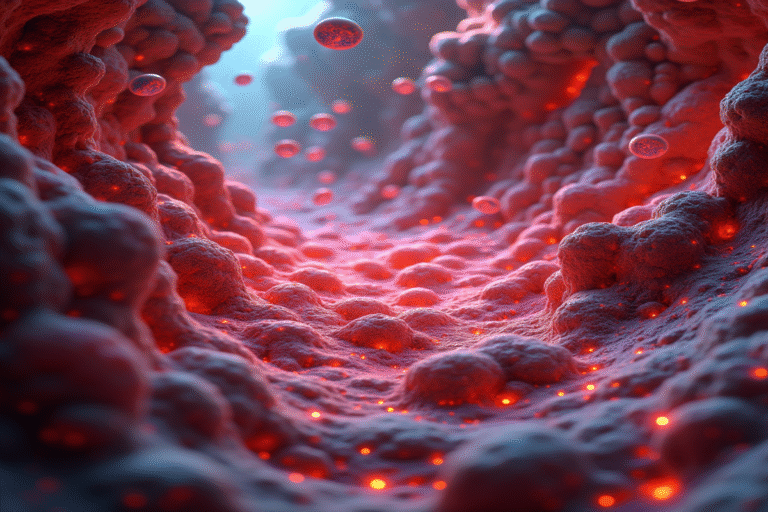Inside your bones right now, an extraordinary factory is working at full capacity. Without any conscious effort on your part, your body is busily producing an astonishing 2.5 million new red blood cells every second. This remarkable process, happening silently within your bone marrow, ensures your survival by constantly renewing your blood supply.
The Hidden Blood Cell Factory
Your body contains approximately 30 trillion red blood cells circulating through your 60,000 miles of blood vessels. What’s truly mind-boggling is that many of these cells have incredibly short lifespans, requiring constant replacement:
- Red blood cells live for about 120 days
- Platelets survive just 8-10 days
- Neutrophils (the most common white blood cell) last only 5-6 hours to a few days
To compensate for this rapid turnover, your bone marrow—the spongy tissue inside your larger bones—produces about 200 billion new blood cells every day. That’s more than 2 million cells every second, enough to replace the entire population of Brazil daily!
The Blood Cell Family Tree
All blood cells begin as hematopoietic stem cells (HSCs)—amazing “master cells” capable of both self-renewal and turning into any blood cell type. These stem cells live in protected areas within your bone marrow, especially in the pelvis, ribs, sternum, and vertebrae.
When it’s time to mature, HSCs first become one of two types of progenitor cells:
- Myeloid progenitor cells—develop into red blood cells, platelets, and most white blood cells
- Lymphoid progenitor cells—become lymphocytes (B cells, T cells, and natural killer cells)
This branching process, known as hematopoiesis, passes through many stages that are tightly regulated by chemical signals called cytokines and growth factors. Each step guides cells toward a specialized role.
Red Blood Cells: The Oxygen Delivery Service
Your body gives top priority to making red blood cells (erythrocytes) because they deliver the oxygen every cell in your body needs. The red blood cell production process, or erythropoiesis, ramps up if your oxygen levels drop.
What makes red blood cells fascinating:
- They shed their nucleus before entering the bloodstream, creating more room for oxygen-carrying hemoglobin
- Each contains about 270 million hemoglobin molecules
- A single red blood cell can travel through your entire body in just 20 seconds
- Your kidneys monitor oxygen levels and release erythropoietin (EPO) to increase production when needed
White Blood Cells: Your Cellular Defenders
While red blood cells get much attention for their abundance (making up about 40-45% of your blood), white blood cells (leukocytes) are essential defenders against infection. Your bone marrow produces several types:
- Neutrophils—First responders that engulf and destroy bacteria
- Eosinophils—Attack parasites and play a role in allergies
- Basophils—Release histamine to help control inflammation
- Monocytes—Turn into macrophages that clean up debris and pathogens
- Lymphocytes—Include B cells (make antibodies), T cells (cell-mediated immunity), and natural killer cells
Impressively, your immune system keeps a careful balance, making enough white blood cells to fight off infections without causing harm to your own body.
Platelets: The Clotting Specialists
Platelets (thrombocytes) are not complete cells, but tiny fragments that break off from giant cells called megakaryocytes in your bone marrow. Each megakaryocyte releases thousands of platelets into circulation.
When you get a cut, platelets react quickly:
- They detect the damaged blood vessel and change shape to become sticky and spiky
- They cling to the broken site and to each other, forming a plug
- They release chemicals that help make the clot stronger and attract even more platelets
- They activate the coagulation cascade, which creates fibrin strands to reinforce the clot
This process keeps you from bleeding too much, even from small injuries.
The Regulation Marvel
What’s truly remarkable is how precisely your body controls blood cell production. Through feedback loops and complex chemical signaling, your body continuously adjusts how many cells are made:
- Low oxygen triggers EPO release, increasing red blood cell production
- Infections prompt the release of granulocyte colony-stimulating factor (G-CSF), boosting neutrophil numbers
- Low platelet counts stimulate thrombopoietin, encouraging more platelet production
This careful regulation explains why healthy people maintain stable blood cell counts, despite the massive turnover each day.
When Blood Production Goes Awry
Understanding the complex nature of blood cell production sheds light on many blood disorders:
- Anemia—red blood cell production can’t keep up with what’s lost
- Leukemia—white blood cell precursors multiply too rapidly and uncontrollably
- Thrombocytopenia—not enough platelets are made or they’re destroyed too quickly
- Polycythemia—the body makes too many red blood cells
Treatments for these conditions often target how bone marrow works. Stem cell transplants, for example, can restart the blood-forming system in severe diseases.
The Future of Blood Science
Scientists are making exciting progress in understanding blood cell production. Current research is focused on:
- Developing artificial blood components for transfusions
- Programming stem cells to create specific blood cell types
- Creating targeted treatments for blood cancers
- Discovering how the bone marrow environment shapes blood cell development
Next time you get a paper cut or donate blood, take a moment to appreciate the incredible regenerative system inside you. Billions of blood cells are produced every day, each programmed for a life-saving job. Your body’s power to renew itself is one of nature’s most impressive achievements—a true daily miracle happening inside your bones.





